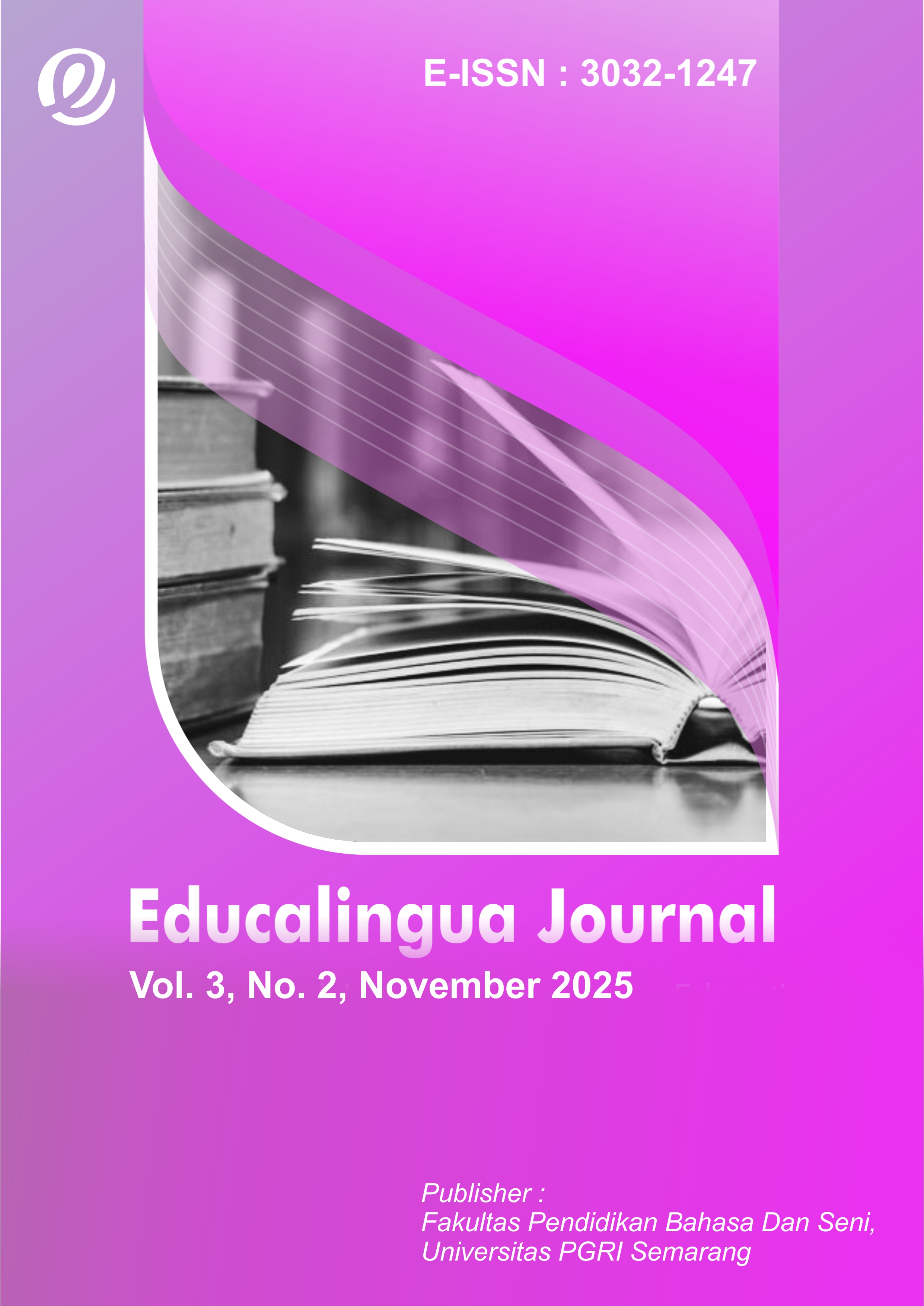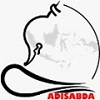Empowering EFL Learners’ Writing Skills through the Employment of Automated Peer Feedback
DOI:
https://doi.org/10.26877/educalingua.v3i2.1964Keywords:
Technology, EFL writing, automated peer feedback, library study, thematic analysisAbstract
Effective feedback provision is essential for enhancing EFL learners’ writing proficiency. Therefore, second language educators need to explore more varied and productive approaches to delivering writing feedback that supports learners’ continuous development. In this regard, the integration of automated peer feedback has emerged as a significant innovation in modern second language writing instruction. It enables learners to acquire richer insights, linguistic knowledge, and writing competencies through digitally mediated peer commentaries. This library-based study employed thematic analysis to examine 30 previously published studies on automated peer feedback. The analysis allowed the researcher to identify recurring themes and interpret relevant findings systematically. The main objective of this investigation was to explore how automated peer feedback empowers EFL learners’ writing skills. The findings revealed that automated peer feedback enhances learners’ writing development by fostering student-centered engagement and collaborative learning environments.
References
Aldosemani, T., Assalahi, H., Lhothali, A., & Albsisi, M. (2023). Automated Writing Evaluation in EFL Contexts: A Review of Effectiveness, Impact, and Pedagogical Implications. International Journal of Computer-Assisted Language Learning and Teaching, 13(1), 1–19. https://doi.org/10.4018/IJCALLT.329962
Alharbi, W. (2023). AI in the Foreign Language Classroom: A Pedagogical Overview of Automated Writing Assistance Tools. Education Research International Journal, 2(3), 1-15. https://doi.org/10.1155/2023/4253331
Barrot, J. S. (2023). Using automated written corrective feedback in the writing classrooms: effects on L2 writing accuracy. Computer Assisted Language Learning Journal, 36(4), 584–607. https://doi.org/10.1080/09588221.2021.1936071
Benali, A. (2021). The Impact of Using Automated Writing Feedback in ESL/EFL Classroom Contexts. English Language Teaching Journal, 14(12), 189-195. https://doi.org/10.5539/elt.v14n12p189
Braun, V., & Clarke, V. (2021). Conceptual and Design Thinking for Thematic Analysis. Qualitative Psychology Journal, 9(1), 3–26. File:///Users/ksiamisang/Desktop/mark.pdf.
Cao, S., Zhou, S., Luo, Y., Wang, T., Zhou, T., & Xu, Y. (2022). A review of the ESL/EFL learners’ gains from online peer feedback on English writing. Frontiers in Psychology Journal, 13(10), 1–13. https://doi.org/10.3389/fpsyg.2022.1035803
Carless, D., & Boud, D. (2018). The development of student feedback literacy: enabling uptake of feedback. Assessment & Evaluation in Higher Education Journal, 43(8), 1315-1325. https://doi.org/10.1080/02602938.2018.1463354
Chang, T. S., Li, Y., Huang, H. W., & Whitfield, B. (2021). Exploring EFL Students’ Writing Performance and Their Acceptance of AI-based Automated Writing Feedback. International Conference Journal, 12(8), 31–35. https://doi.org/10.1145/3459043.3459065
Chen, M., & Cui, Y. (2022). The effects of AWE and peer feedback on cohesion and coherence in continuation writing. Journal of Second Language Writing, 57(9), 21-33. https://doi.org/10.1016/j.jslw.2022.100915
Cheng, G., Chwo, G. S. M., & Ng, W. S. (2023). Automated tracking of student revisions in response to teacher feedback in EFL writing: technological feasibility and teachers’ perspectives. Interactive Learning Environments Journal, 31(8), 5236–5260. https://doi.org/10.1080/10494820.2021.2001539
Ciampa, K., & Wolfe, Z. M. (2023). From isolation to collaboration: creating an intentional community of practice within the doctoral dissertation proposal writing process. Teaching in Higher Education Journal, 28(3), 487–503. https://doi.org/10.1080/13562517.2020.1822313
Elboshi, A. (2021). Web-Enhanced Peer Feedback in ESL Writing Classrooms A Literature Review. English Language Teaching Journal, 14(4), 66-76. https://doi.org/10.5539/elt.v14n4p66
Fan, N. (2023). Exploring the Effects of Automated Written Corrective Feedback on EFL Students’ Writing Quality: A Mixed-Methods Study. SAGE Open Journal, 13(2), 1–17. https://doi.org/10.1177/21582440231181296
Fan, N., & Ma, Y. (2022). The Effects of Automated Writing Evaluation (AWE) Feedback on Students’ English Writing Quality: A Systematic Literature Review. Language Teaching Research Quarterly, 28(12), 53–73. https://doi.org/10.32038/ltrq.2022.28.03
Guo, Q., Feng, R., & Hua, Y. (2022). How effectively can EFL students use automated written corrective feedback (AWCF) in research writing? Computer Assisted Language Learning Journal, 35(9), 2312–2331. https://doi.org/10.1080/09588221.2021.1879161
Hasim, Z., Alias, N. R., & Sauffi, K. M. (2024). The Effectiveness of Online Feedback and Automated Writing Feedback in Improving Writing : A Systematic Literature Review. Asian Journal of Research in Education and Social Sciences, 6(2), 900–912. https://myjms.mohe.gov.my/
Huang, S., & Renandya, W. A. (2020). Exploring the integration of automated feedback among lower-proficiency EFL learners. Innovation in Language Learning and Teaching Journal, 14(1), 15–26. https://doi.org/10.1080/17501229.2018.1471083
Jiang, L., & Yu, S. (2022). Appropriating automated feedback in L2 writing: experiences of Chinese EFL student writers. Computer Assisted Language Learning Journal, 35(7), 1329–1353. https://doi.org/10.1080/09588221.2020.1799824
Jingxin, G., & Razali, A. B. (2020). Tapping the Potential of Pigai Automated Writing Evaluation (AWE) Program to Give Feedback on EFL Writing. Universal Journal of Educational Research, 8(12), 8334–8343. https://doi.org/10.13189/ujer.2020.082638
Klassen, A. C., Creswell, J., Plano Clark, V. L., Smith, K. C., & Meissner, H. I. (2012). Best practices in mixed methods for quality of life research. Quality of Life Research Journal, 21(3), 377–380. https://doi.org/10.1007/s11136-012-0122-x
Koltovskaia, S. (2020). Student engagement with automated written corrective feedback (AWCF) provided by Grammarly: A multiple case study. Assessing Writing Journal, 44(2), 1-12. https://doi.org/10.1016/j.asw.2020.100450
Lee, Y. J. (2020). The long-term effect of automated writing evaluation feedback on writing development. English Teaching Journal, 75(1), 67–92. https://doi.org/10.15858/engtea.75.1.202003.67
Li, L., & Kim, M. (2024). It is like a friend to me: Critical usage of automated feedback systems by self-
regulating English learners in higher education. Australasian Journal of Educational Technology, 40(1), 1–18. https://doi.org/10.14742/ajet.8821
Li, W. Y., Kau, K., & Shiung, Y. J. (2023). Pedagogic Exploration Into Adapting Automated Writing Evaluation and Peer Review Integrated Feedback Into Large-Sized University Writing Classes. SAGE Open Journal, 13(4), 1–18. https://doi.org/10.1177/21582440231209087
Liaqat, A., Munteanu, C., & Demmans Epp, C. (2021). Collaborating with Mature English Language Learners to Combine Peer and Automated Feedback: a User-Centered Approach to Designing Writing Support. International Journal of Artificial Intelligence in Education, 31(4), 638–679. https://doi.org/10.1007/s40593-020-00204-4
Lin, V., Liu, G. Z., & Chen, N. S. (2022). The effects of an augmented-reality ubiquitous writing application: a comparative pilot project for enhancing EFL writing instruction. Computer Assisted Language Learning Journal, 35(5), 989–1030. https://doi.org/10.1080/09588221.2020.1770291
Link, S., Mehrzad, M., & Rahimi, M. (2022). Impact of automated writing evaluation on teacher feedback, student revision, and writing improvement. Computer Assisted Language Learning Journal, 35(4), 605–634. https://doi.org/10.1080/09588221.2020.1743323
Liu, C. C., Hwang, G. J., Yu, P., Tu, Y. F., & Wang, Y. (2025). Effects of an automated corrective feedback-based peer assessment approach on students’ learning achievement, motivation, and self-regulated learning conceptions in foreign language pronunciation. Educational Technology Research and Development Journal, 5(3), 1-22. https://doi.org/10.1007/s11423-025-10484-z
Moses, R. N., & Mohamad, M. (2019). Challenges Faced by Students and Teachers on Writing Skills in ESL Contexts: A Literature Review. Creative Education Journal, 10(13), 3385–3391. https://doi.org/10.4236/ce.2019.1013260
Ngo, T. T. N., Chen, H. H. J., & Lai, K. K. W. (2024). The effectiveness of automated writing evaluation in EFL/ESL writing: A three-level meta-analysis. Interactive learning environments journal, 32(2), 727-744. https://doi.org/10.1080/10494820.2022.2096642
Nowell, L. S., Norris, J. M., White, D. E., & Moules, N. J. (2017). Thematic Analysis: Striving to Meet the Trustworthiness Criteria. International Journal of Qualitative Methods, 16(1), 1–13. https://doi.org/10.1177/1609406917733847
Osman, A., Al-Badriyeh, D., Hussain, F. N., Riaz, S., Elewa, H., & Mraiche, F. (2022). The design and implementation of an undergraduate health professional degree elective course on scientific writing, peer assessment, and critical appraisal. Currents in Pharmacy Teaching and Learning Journal, 14(6), 765–772. https://doi.org/10.1016/j.cptl.2022.06.008
Pham, T. N., Lin, M., Trinh, V. Q., & Bui, L. T. P. (2020). Electronic Peer Feedback, EFL Academic Writing and Reflective Thinking: Evidence From a Confucian Context. SAGE Open Journal, 10(1), 1-20. https://doi.org/10.1177/2158244020914554
Rahimi, M., Fathi, J., & Zou, D. (2024). Exploring the impact of automated written corrective feedback on the academic writing skills of EFL learners: An activity theory perspective. Education and Information Technologies Journal, 30(7), 2691–2735. https://doi.org/10.1007/s10639-024-12896-5
Razali, K. A., Rahman, Z. A., Ahmad, I. S., & Othman, J. (2021). Malaysian ESL Teachers’ Practice of Written Feedback on Students’Writing. Pertanika Journal of Social Sciences and Humanities, 29(3), 47–67. https://doi.org/10.47836/pjssh.29.s3.03
Salavatizadeh, M., & Tahriri, A. (2020). The Effect of Blended Online Automated Feedback and Teacher Feedback on EFL Learners’ Essay Writing Ability and Perception. Journal of Teaching Language Skills, 39(3), 181–225. https://doi.org/10.22099/jtls.2021.38753.2899
Sanosi, A. B. (2022). the Impact of Automated Written Corrective Feedback on Efl Learners’ Academic Writing Accuracy. Journal of Teaching English for Specific and Academic Purposes, 10(2), 301–317. https://doi.org/10.22190/JTESAP2202301S
Saricaoglu, A., & Bilki, Z. (2021). Voluntary use of automated writing evaluation by content course students. RECALL Journal, 33(3), 265–277. https://doi.org/10.1017/S0958344021000021
Schillings, M., Roebertsen, H., Savelberg, H., & Dolmans, D. (2023). A review of educational dialogue strategies to improve academic writing skills. Active Learning in Higher Education Journal, 24(2), 95–108. https://doi.org/10.1177/1469787418810663
Shadiev, R., & Feng, Y. (2024). Using automated corrective feedback tools in language learning: a review study. Interactive Learning Environments Journal, 32(6), 2538–2566. https://doi.org/10.1080/10494820.2022.2153145
Shang, H. F. (2022). Exploring online peer feedback and automated corrective feedback on EFL writing performance. Interactive Learning Environments Journal, 30(1), 4–16. https://doi.org/10.1080/10494820.2019.1629601
Shi, H., & Aryadoust, V. (2024). A systematic review of AI-based automated written feedback research. RECALL Journal, 36(2), 187–209. https://doi.org/10.1017/S0958344023000265
Siekmann, L., Parr, J., Van Ophuysen, S., & Busse, V. (2023). Text quality and changing perceptions of teacher feedback and affective-motivational variables: a study with secondary EFL students. Frontiers in Education Journal, 8(5), 1–16. https://doi.org/10.3389/feduc.2023.1171914
Spring, R. (2024). The impact of note-taking , peer feedback , and automated feedback on summary writing : A study in the Japanese EFL context. International Journal of English for Academic Purposes, 4(2), 177-196. https://doi.org/10.3828/ijeap.2024.11
Taskiran, A., Yazici, M., & Erdem Aydin, I. (2024). Contribution of automated feedback to the English writing competence of distance foreign language learners. E-Learning and Digital Media Journal, 21(1), 24–41. https://doi.org/10.1177/20427530221139579
Tian, L., & Zhou, Y. (2020). Learner engagement with automated feedback, peer feedback and teacher feedback in an online EFL writing context. Elsevier Journal, 4(1), 1-14. https://doi.org/10.1016/j.system.2020.102247
Vygotsky, L., & Cole, M. (2018). Lev Vygotsky: Learning and social constructivism. Learning Theories for Early Years Practice. UK: SAGE Publications Inc, 68-73.
Wang, Z., & Han, F. (2022). The Effects of Teacher Feedback and Automated Feedback on Cognitive and Psychological Aspects of Foreign Language Writing: A Mixed-Methods Research. Frontiers in Psychology Journal, 13(7), 1–12. https://doi.org/10.3389/fpsyg.2022.909802
Wei, P., Wang, X., & Dong, H. (2023). The impact of automated writing evaluation on second language writing skills of Chinese EFL learners: a randomized controlled trial. Frontiers in Psychology Journal, 14(9), 1–11. https://doi.org/10.3389/fpsyg.2023.1249991
Wei, Y., & Liu, D. (2024). Incorporating peer feedback in academic writing: a systematic review of benefits and challenges. Frontiers in Psychology Journal, 15(11), 1–14. https://doi.org/10.3389/fpsyg.2024.1506725
Woodworth, J., & Barkaoui, K. (2020). Perspectives on Using Automated Writing Evaluation Systems to Provide Written Corrective Feedback in the ESL Classroom. TESL Canada Journal, 37(2), 234–247. https://doi.org/10.18806/tesl.v37i2.1340
Yallop, R., Taremaa, P., & Leijen, D. (2021). The affect and effect of asynchronous written feedback comments on the peer feedback process: An ethnographic case-study approach within one L2 English doctorate writing group. Journal of Writing Research, 12(3), 531-594. https://doi.org/10.17239/jowr-2021.12.03.02
Yang, H., Gao, C., & Shen, H. Z. (2024). Learner interaction with, and response to, AI-programmed automated writing evaluation feedback in EFL writing: An exploratory study. Education and Information Technologies Journal, 29(4), 3837–3858. https://doi.org/10.1007/s10639-023-11991-3
Zhai, N., & Ma, X. (2022). Automated writing evaluation (AWE) feedback: a systematic investigation of college students’ acceptance. Computer Assisted Language Learning Journal, 35(9), 2817–2842. https://doi.org/10.1080/09588221.2021.1897019
Zhang, D., Tan, J. T. A., & Roy, S. S. (2023). A systematic review of interventions improving university students’ EFL writing competence. International Journal of Learning, Teaching and Educational Research, 22(10), 93-112. https://www.ijlter.myres.net/
Zimmerman, B. J. (2002). Becoming a self-regulated learner: An overview. Theory into practice Journal, 41(2), 64-70. https://doi.org/10.1207/s15430421tip4102_2
Downloads
Published
Issue
Section
License
Copyright (c) 2025 Educalingua Journal

This work is licensed under a Creative Commons Attribution-NonCommercial-ShareAlike 4.0 International License.





